Monday, 1 July, Basel: internationality and wickelfisch
Written 27 August 2019
Some time in the night, we arrived in Basel, where we had to have our bags packed and set outside our stateroom doors by 6 a.m., so that Viking stevedores could collect them and load them onto our respective buses. We had dutifully attached our orange tags, marked with our names and stateroom numbers, so that they would wind up on the orange bus, which we would board at 9:15 a.m. (The bus was actually white, like all Viking buses, but the identifying sign in its window, and the lollipops carried by the guides aboard it, depicted orange luggage tags.)
Breakfast started half an hour early, at 6:30 a.m., and we were asked to vacate our staterooms by 8:30 a.m. (and to bring our hand luggage and Quietvoxes along), so that the staff could have a little extra time to service them—the passengers on the next cruise, heading back toward Paris, would board that very afternoon.
Basel is located at the "dreiländereck" (three-land corner), where Germany, France, and Switzerland meet. Downstream, back toward Strasbourg, the Rhine forms the border between Germany and France, and upstream, it forms the border between Germany and Switzerland, but where the river passes through Basel, the border veers away from it to go around the city, so all of Basel is in Switzerland, even though it lies on both banks of the river.
Basel is Switzerland's 3rd largest city (200,000 population; Switzerland has 8.4 million), after Zurich and Geneva. It occupies 14 square miles and is the nation's only port. It has two container terminals now, and two more will open within a year. About 8 million cargo tonnes arrive in Basel yearly.
At 8 a.m., the passengers who had chosen the "Highlights of the Alps" excursion boarded their buses. We would see them again that evening at the hotel in Zurich.

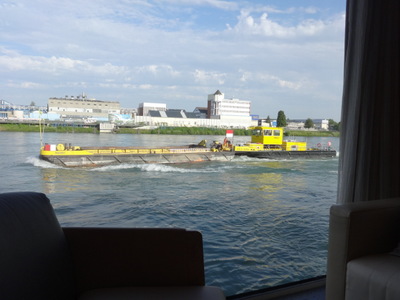 While we ate our breakfast, a barge cruised by that had clearly been retrofitted (left-hand photo); it was called Lorin and was registered in Basel. It rode high in the water and had windows all along its sides. At the time, I took it for a hotel barge, like the Linquenda, on which we toured Champagne many years ago, but as I study the photo, I'm not so sure. The Linquenda had a cabin above the deck with dining tables and panoramic windows, but this boat doesn't, and all signs of living activities (café tables and chairs, flower pots) are confined to the after deck,. Someone clearly lives aboard, but maybe the windows are actually some sort of special cargo fitting . . .
While we ate our breakfast, a barge cruised by that had clearly been retrofitted (left-hand photo); it was called Lorin and was registered in Basel. It rode high in the water and had windows all along its sides. At the time, I took it for a hotel barge, like the Linquenda, on which we toured Champagne many years ago, but as I study the photo, I'm not so sure. The Linquenda had a cabin above the deck with dining tables and panoramic windows, but this boat doesn't, and all signs of living activities (café tables and chairs, flower pots) are confined to the after deck,. Someone clearly lives aboard, but maybe the windows are actually some sort of special cargo fitting . . .
At the right, the Alladin is clearly a working boat.
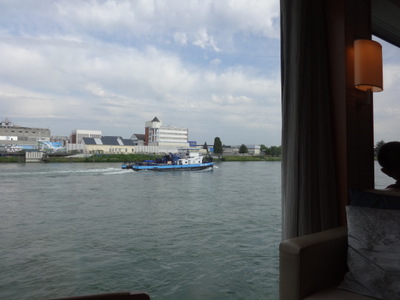
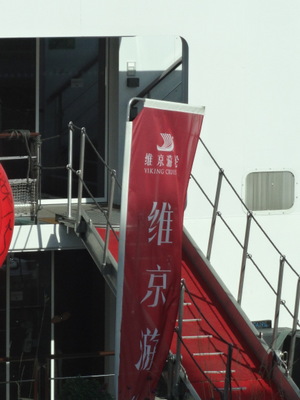 I think the little blue boat at the left is a tug
I think the little blue boat at the left is a tug
Perhaps the most surprising boat we saw, though, was the Viking Odin (right). We were moored outboard of her and had to walk through her main lobby to disembark. As you can see from the banner by the gangway, the entire ship was Chinese! Or at least the staff and passengers were—I can't vouch for the ship's crew. Apparently Viking has decided that the next big market for their European cruises is prosperous Chinese, so the Odin is one of several Chinese-language boats now cruising the rivers of Europe.
Switzerland is not part of the EU, so they don't use the Euro—we were advised to change as little money as possible into Swiss francs, unless we planned to spend time in Switzerland in the future. Local businesses all take credit cards, and some will even take euros or other foreign currency.
Switzerland is, however, part of the Schengen area, so no passport formalities were needed when we crossed into it from Germany.
The bus took us first for a short drive through Klein Basel (Little Basel), the part on the right bank (the side away from the rest of Switzerland). Basel is so international that its three railway stations are run by three different national railway systems. The Basel Badischer Bahnhoff, the German station, is in Klein Basel, the others are together on the other side of the river.

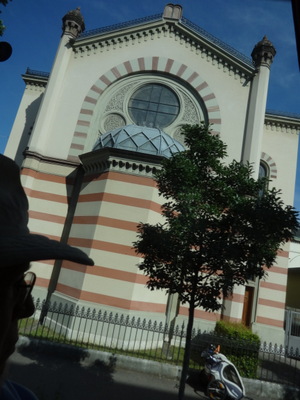 Back in Grosse Basel (Big Basel), we drove by the Gate of Spalen (the Spalentorm, left), which is, of course, left over from the old city wall. It's now a major landmark and so central that we drove by it several times in the course of our bus tour.
Back in Grosse Basel (Big Basel), we drove by the Gate of Spalen (the Spalentorm, left), which is, of course, left over from the old city wall. It's now a major landmark and so central that we drove by it several times in the course of our bus tour.
My photo is marred not just by reflections in the bus windows but by the criss-crossed overhead electrical wires of a dozen tram lines. Trams are everywhere.
On the right is the city's main synagogue. This photo shows only one wing of the building. The central door is flanked by two wings like this, and we were way to close to the building to get a shot that shows the two enormous domes that top the structure. It's 200 years old and serves nearly 2000 members. According to our guide, in 1897, the first gathering of zionists planning for the birth of Israel met here in Basel. Basel also has Switzerland's only Jewish museum.
We also drove past the gigantic main train station, but I wasn't able to get a good photo. It includes a large performance and conference venue that hosts frequent events. In the spring, there's a huge trade fair for watches and jewwlery. It also has a shopping mall, and the stores there are almost the only ones open on Sunday, so it's a major social center, especially on weekends. It's also the busiest border railway station in Europe.

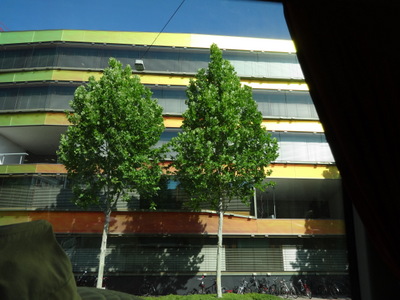 Another building we drove by several times is the Children's hospital. The architect wanted to make it nonintimidating to children, so on all four sides, he installed these prismatic panels that change apparent color as you walk or drive by. As you approach, they're green, but they change to yellow and then to deep orange, gold, and red as you pass, then fade to green again behind you. Amazing!
Another building we drove by several times is the Children's hospital. The architect wanted to make it nonintimidating to children, so on all four sides, he installed these prismatic panels that change apparent color as you walk or drive by. As you approach, they're green, but they change to yellow and then to deep orange, gold, and red as you pass, then fade to green again behind you. Amazing!
The guide said that 2000 babies a year are born in the gynecological hospital, which is across the street from the children's hospital but not so spectacular in appearance.
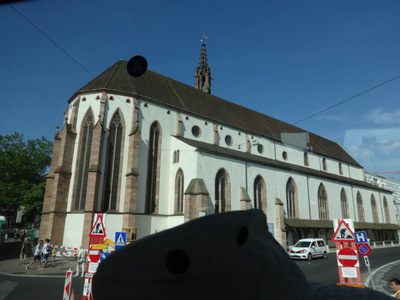
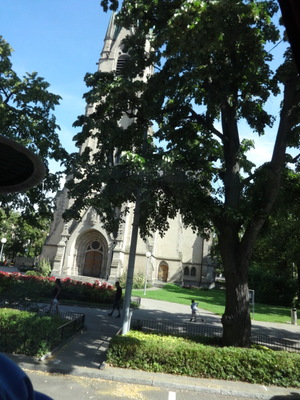 At the left, I think this is the Lutheran church, but it could be St. Peter's (also protestant).
At the left, I think this is the Lutheran church, but it could be St. Peter's (also protestant).
At the right, I have no idea. They showed us too many churches, and I couldn't keep them straight. St. Elizabeth's, maybe?
One 19th century church, marked by the blue clockface in its tower, is an open ecumenical church. It was originally protestant. Now it serves the internaional community who might not have a church nearby. It has a tearoom and a cafe inside, organizes dance classes and flea markets, and is still well attended.

 At the left here is a view of Basel Cathedral from the bus, on its way to drop us off for our city walking tour. It has the same sort of colored tile roof as the Hospices de Beaune and so many other churches in Burgundy (see my 2009 travel diary).
At the left here is a view of Basel Cathedral from the bus, on its way to drop us off for our city walking tour. It has the same sort of colored tile roof as the Hospices de Beaune and so many other churches in Burgundy (see my 2009 travel diary).
About 10 a.m., the bus dropped us off at the Tinguely fountain, a major landmark in the city. Right next to it is a large restaurant that doesn't open until noon, so Viking has struck up an agreement with the management to open its large restrooms for the convenience of Viking tour groups! Clever.
Jean Tinguely (1925–1991) was born in Bern, Switzerland, and was best known for his "kinetic" art that satirized automation. Several of the mechanical figures that stand in the fountain wobble or spin or otherwise move, spouting water all the while. Our guide emphsized that with just on exception, all the city's hundreds of fountains—one on almost every street corner—spout potable water. The Tinguely fountain is the only exception, so, she said, refill your water bottle at any other fountain you come to, but not this one!
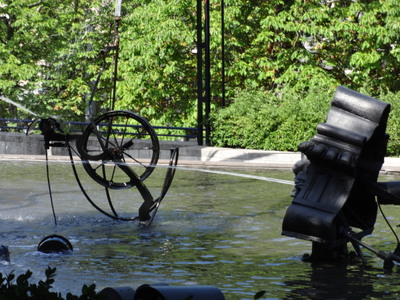
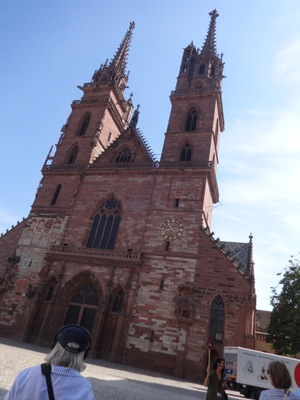 At the left here is closer view of a couple of the figures in the fountain. We've also visited the Stravinsky Fountain in Paris, on which Tinguely collaborated with his second wife, Niki de Saint Phalle, who was also an artist and has several works displayed in Basel, including in the conference venue in the train station. It was only when I looked her up to make sure I had her name spelled right that I realized she spent a lot of time in San Diego and was in fact the creator of the Sun God on the UCSD campus, affectionately know there as Big Bird! The Stravinsky's kinship with both the the Basel fountain and Big Bird is obvious, once you know.
At the left here is closer view of a couple of the figures in the fountain. We've also visited the Stravinsky Fountain in Paris, on which Tinguely collaborated with his second wife, Niki de Saint Phalle, who was also an artist and has several works displayed in Basel, including in the conference venue in the train station. It was only when I looked her up to make sure I had her name spelled right that I realized she spent a lot of time in San Diego and was in fact the creator of the Sun God on the UCSD campus, affectionately know there as Big Bird! The Stravinsky's kinship with both the the Basel fountain and Big Bird is obvious, once you know.
At the right is a closer view of the Basel cathedral, the largest protestant cathedral in the city. It's built of the same dark pink sandstone as the one in Strasbourg. The stone is soft, so the building is usually under repair; the guide said we were lucky it wasn't covered with scaffolding on this day we saw it.
In the Münsterplatz, the big open plaza in front of the cathedral, the city operates an open-air cinema, fun fairs form time to time, and New Year's Eve parties. The cathedral stages the only protestant carnival, a week later than all the catholic ones.
Written 29 August 2019

 Basel was Catholic until the reformation; since then it's been mainly Presbyterian. At the right here is a close-up of of St. Martin sharing his cloak with the beggar, but for some reason the beggar was removed at the reformation (why?), so now he's just cutting his cloak in half for no obvious reason.
Basel was Catholic until the reformation; since then it's been mainly Presbyterian. At the right here is a close-up of of St. Martin sharing his cloak with the beggar, but for some reason the beggar was removed at the reformation (why?), so now he's just cutting his cloak in half for no obvious reason.
In 1356, Basel suffered a terrible earthquake (no, not the same one that devastated Lisbon; I looked it up, and that wasn't until 1531), and the Romanesque church with five bell towers came down, but the walls of the side aisles stood, and the rebuilt part is Gothic.
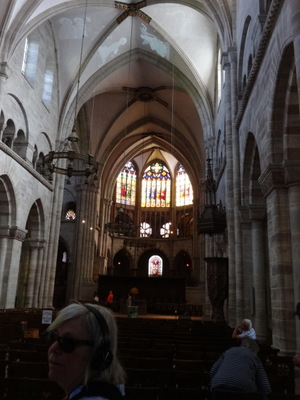
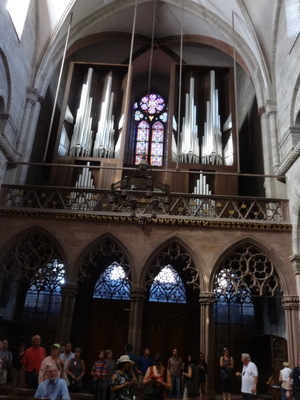 At the left here is a new of the nave, and at the right a view in the other direction toward the organ. The organ is quite recent, only 13 years old. It has (I think she said) 1100 pipes. The stained glass is 19th century; the church has no altars.
At the left here is a new of the nave, and at the right a view in the other direction toward the organ. The organ is quite recent, only 13 years old. It has (I think she said) 1100 pipes. The stained glass is 19th century; the church has no altars.
In one of the side aisles, the guide showed us the inscription and grave of Erasmus or Rotterdam, who came here for the printing and binding trade. He primary trade was book illustrator.
One reason Erasmus moved to Basel is that, in the 15th century, a huge eccliastical meeting was held in Basel that went on for 18 years! According to the guide, it decided nothing much in the end, but it gave Basel a huge surge forward. The university opened, and paper making, book printing, and book binding boomed. A Bible was printed here in the original GReek, with parallel Latin translation—Gutenberg only printed the Latin.
The nave is furnished with hundreds of wooden chairs with a wide variety of chair backs, all hand carved in the 18th century.

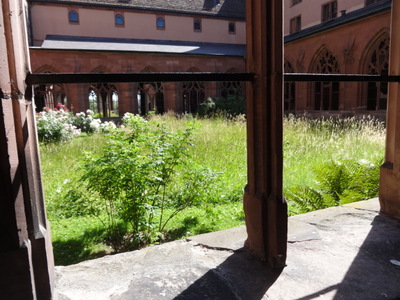 The cloister, as usual, was beautiful—that's David up ahead of me in the blue shirt and Tilly hat—but for some reason the garden in the center (right-hand photo) has been allowed to go to weeds and ruin.
The cloister, as usual, was beautiful—that's David up ahead of me in the blue shirt and Tilly hat—but for some reason the garden in the center (right-hand photo) has been allowed to go to weeds and ruin.
The university founded during the ecclesiastical meeting dates from 1460; it's Switzerland's oldest and has about 13,000 students today. It's apparently an excellent institution, but to study polytechnical matters, you go to the much more recent university in Zurich. It has an Institute of Science and Technology, but Basel's university doesn't. Basel also has a second, much younger university in Zurich. Other big towns in Switzerland have universities, but they date from the 19th century
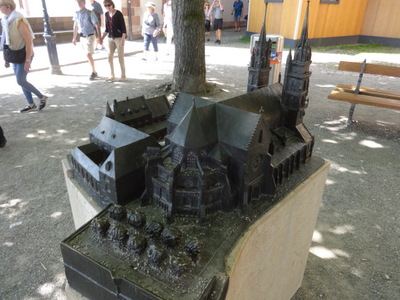
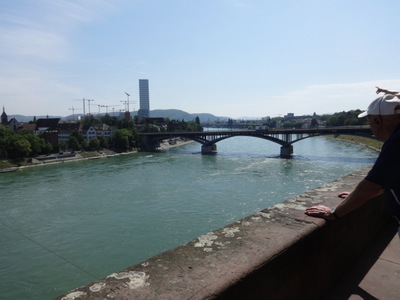 Like many of the other major churches we've visited on this trip, this one also has a bronze scale model outside, labeled in Braille.
Like many of the other major churches we've visited on this trip, this one also has a bronze scale model outside, labeled in Braille.
The next stop on the walking tour was a bluff high above the Rhine. Six bridges cross the Rhine in Basel, but because the river curves, you can never see all the bridges at once. I only caught one here.
The river used to be terribly polluted, but as a result of huge efforts is now so clean that salmon have come back, all the way from the Atlantic! The salmon still have trouble getting past the locks, so clearly they need to put in some salmon ladders.

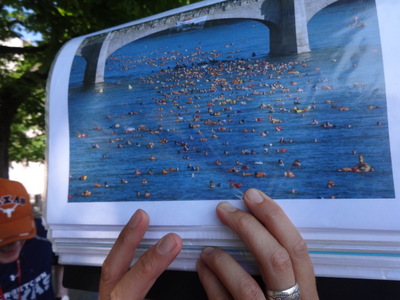 Because the water is now clean and safe, it has become very popular for swimming. All over the city, you see people walking around carrying lightweight, brightly colored, bags made of ripstop nylon and shaped like fish. They're called "wickelfisch," they come in large and small, and you can buy them just about anywhere. They're waterproof, so you can put your clothes, briefcase, phone, and everything else inside, go straight to the river from work, hop in and float/swim downstream the length of the city, climb out, and take the tram or bus home. If you blow up the empty space inside with air, you can use it as a float, and they come equipped with straps so that you can wear them like a backpack or fasten them around your waist. They were invented here in Basel, although (the guide said with disdain) people in Zurich have copied the idea.
Because the water is now clean and safe, it has become very popular for swimming. All over the city, you see people walking around carrying lightweight, brightly colored, bags made of ripstop nylon and shaped like fish. They're called "wickelfisch," they come in large and small, and you can buy them just about anywhere. They're waterproof, so you can put your clothes, briefcase, phone, and everything else inside, go straight to the river from work, hop in and float/swim downstream the length of the city, climb out, and take the tram or bus home. If you blow up the empty space inside with air, you can use it as a float, and they come equipped with straps so that you can wear them like a backpack or fasten them around your waist. They were invented here in Basel, although (the guide said with disdain) people in Zurich have copied the idea.
In the photo at the left, even at 10 a.m. on a Monday, you can just make out (despite telephoto), two guys with blue and green wickelfisch paddling around down below. At the right is a photo the guide held up of the river on national river-appreciation day. They must have had to close the shipping lane, because the river is filled bank to bank with swimmers, each with a brightly colored fish bag.
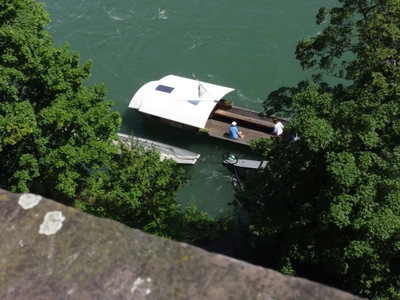
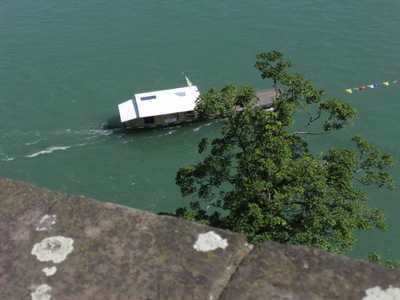 Almost straight down below us was a small wooden ferry boat that would hold maybe 20 or 30 people. It was tethered by a cable decorated with colored flags to a larger cable that stretched across the river from side to side.
Almost straight down below us was a small wooden ferry boat that would hold maybe 20 or 30 people. It was tethered by a cable decorated with colored flags to a larger cable that stretched across the river from side to side.
The boatman held the rudder at an angle that caused the power of the river's current to propel the boat more or less sideways from one bank to the other, its tether sliding along the main cable. To come back, he changed the angle so that the current pushed him back the other way! Clever.
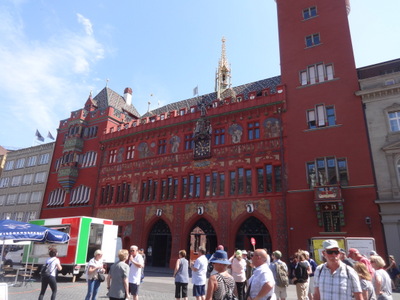
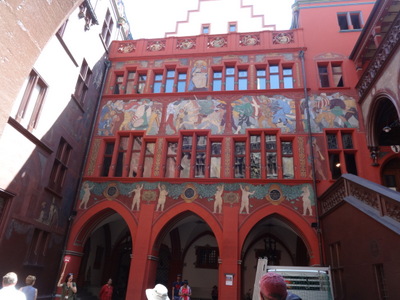 This extremely red building is Basel's town hall. It is brightly painted inside and out with a wide variety of motifs and, like the cathedral, has a colored tile roof. The little steeple on top has one bell in it, presumably to ring the hours, announce town meetings, or some such. The row of shields along the lower edge of the roof are painted with symbols (though a couple are blank); some look like the signs of the zodiac or maybe the attributes of apostles. One is a guy with a shoulder bag, a halo, and a shepherd's crook (St. James?).
This extremely red building is Basel's town hall. It is brightly painted inside and out with a wide variety of motifs and, like the cathedral, has a colored tile roof. The little steeple on top has one bell in it, presumably to ring the hours, announce town meetings, or some such. The row of shields along the lower edge of the roof are painted with symbols (though a couple are blank); some look like the signs of the zodiac or maybe the attributes of apostles. One is a guy with a shoulder bag, a halo, and a shepherd's crook (St. James?).
Just below the clock, an inscription says "Renovato et amplificatum anno domini MDCCCCI," which I take to mean "renovated and enlarged in 1901." Just over the lowest window of the tower, another says "1501 1901," so perhaps the building was renovated for its 400th anniversary.
We went in through one of the three arches and found ourselves in the building's inner courtyard, also intensely red and vividly painted and also with three arches on the far wall, but we didn't go any farther inside. Just above the arches, a row of potbellied but wingless cherubs hold up a garland of oak leaves. Of the three inscriptions above the doors, I could only readily translate the middle one—"Freiheit ist uber silber und gold"—which I take to mean "freedom is above silver and gold." Above the windows (which are, themselves, stained glass, but they weren't backlit so I couldn't tell what they depict) is a procession of knights, cavaliers, swordsmen, squires, and so on parading proudly with the Swiss flag. Above them, in the center, is a man on a throne with a crown and scepter. He's holding a model of the cathedral in the crook of the other arm, so maybe he's the archbishop or God. Finally, across the top in round medalions are a series of mermen, and perhaps mermaids, presumably river dwellers, in this landlocked country.
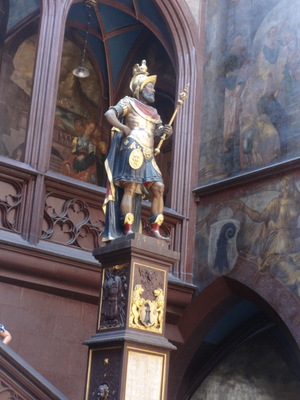
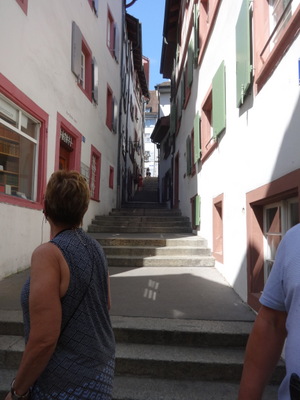 To might right as I took the last photo, at the bottom of the staircase, is this statue of Lucius Munatius Plancus, Roman founder of Basel. At the time the statue went up, the Romans were thought to have founded the city, but 40 years ago, somebody proved that the Helvetians (a Celtic tribe) had built a town here before the Romans showed up. Interestingly, Lucius Munatius Plancus is also cited as the founder of Lyon, in France, but I don't whether someone else was there ahead of him too.
To might right as I took the last photo, at the bottom of the staircase, is this statue of Lucius Munatius Plancus, Roman founder of Basel. At the time the statue went up, the Romans were thought to have founded the city, but 40 years ago, somebody proved that the Helvetians (a Celtic tribe) had built a town here before the Romans showed up. Interestingly, Lucius Munatius Plancus is also cited as the founder of Lyon, in France, but I don't whether someone else was there ahead of him too.
From the town hall, the guide led us through some of the tiny streets of the old city, including the one shown here at the right, so steep that it breaks into short staircases.
Back in this area, we visited St. Andrews Square, where the fountain takes the shape of a monkey, and the street names reflect their old market specialties, like Pfeffergasslein (pepper alley), Imbergasslein (ginger alley). They all date from the 15th century, built after the earthquake.

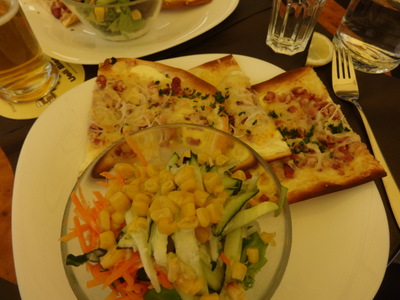 In one of those narrow streets we passed the Morrison Hotel (named for Jim Morrison), which is apparently quite famous among a crtain set of people. The owner commissioned this mural on the flat wall across the street from his front door, and inside, you can visit his extensive collection of rock memorabilia.
In one of those narrow streets we passed the Morrison Hotel (named for Jim Morrison), which is apparently quite famous among a crtain set of people. The owner commissioned this mural on the flat wall across the street from his front door, and inside, you can visit his extensive collection of rock memorabilia.
When we reached the main shopping street again, the guide pointed out to us the route back to our rendez-vous point with the Viking buses and turned us loose for lunch. I especially wanted to get a flammekuche, while we were in flammejuche country, and I had spotted it on the menu of the Huguenin, the restaurant next to the Tinguely fountain, conveniently near our rendez-vous point. So we strolled back up the shopping street, ducked through the shortcut the guide had showed us next to the Louis Vuitton store, and settled at a table on the terrace with a view of the fountain.
At the right here is the lunch we both ordered: a salad in a tall glass bowl with cold corn kernels all over the top and a small flammekuche cut into three pieces and overlapped to fit on the plate. We've been served individual flammekuchen that were, no kidding, 2 ft square, but this was somewhat smaller. The basic flammekuche (literally "flame cake") is dough rolled paper thin—thinner than a thin-crust pizza, thinner than a cracker, really thin—spread with slightly soured cream and sprinkled with soft cooked onions, bacon bits, and grated gruyère and baked in a ferociously hot oven until the edges begin to blacken, then served hot enough to burn your mouth. Yummy. You can get variations, like more cheese, or mushrooms, or a raw egg baked on top. [Note added later: I have since worked out a recipe for an acceptable "sort of" flammekuche, based on a skillet pizza recipe I saw on Facebook. You cook your onions, prepare your bacon (or bits of ham, diced prosciutto, lardons, whatever), and mix sour cream with heavy cream to taste. You heat your oven to, say 450°F, then heat your cast iron skillet really hot, too. Drop a flour tortilla into the skillet, quickly apply your toppings, and put the skillet in your hot oven for a few minutes, until the edges of the tortilla begin to blacken. Also yummy.]
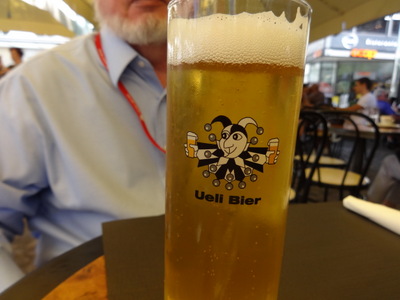
 With his lunch, David had a glass of this local beer.
With his lunch, David had a glass of this local beer.
I tried the strawberries Melba, and yes, Swiss strawberries are pretty good, too.
After lunch, we crossed the street to the bus rendez-vous and people-watched while we waited. Actually, we spent a lot of time observing the passing trams. Several lines ran up and down this rather busy street, and they passed quite frequently. We were impressed with the whole system.
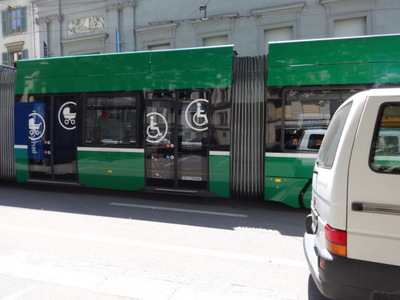 One thing I noticed right away was the occurrence in each tram of cars with these markings on the doors. Some had one marking, some the other, and some had both (or neither). We didn't see either of them used, but apparently, the threshold of the door does something special when it opens to allow entry to wheeled conveyances, and presumably something different for wheelchairs and for strollers and baby carriages.
One thing I noticed right away was the occurrence in each tram of cars with these markings on the doors. Some had one marking, some the other, and some had both (or neither). We didn't see either of them used, but apparently, the threshold of the door does something special when it opens to allow entry to wheeled conveyances, and presumably something different for wheelchairs and for strollers and baby carriages.
The trams came in several colors and were obviously of different vintages. We never figured out whether they're all municipal or whether they're operated by different private companies.
At the appointed hour (2 p.m., so as to reach our Zurich hotel about 3 p.m., when our rooms should be ready for us), the bus with the orange luggage tag appeared, and we left Basel for Zurich.
I didn't get any photos on the way, but here are some other things the guides told us about Basel and about Switzerland:
Basel's main industry is chemicals and pharmaceuticals. Novartis and Roche are both based there and are the largest employers in town. The industry started when the Huguenots came to the city after the reformation. They brought new trades and new commercial know-how, including weaving and dyeing, especiall a major silk dyeing and silk ribbon industry. In the 18th century, the dyers began using synthetic dyes, which led evolved into the chemical, and later, the pharmaceutical industries. Meanwhile, Calvin (in Geneva) made wearing jewelry a sin, so the goldsmiths left Geneva for Basel. The huguenots brought watch-making know-how, and that's where Switzerland's reputation for watch-making started.
The Basel airport is the only three-nation airport in the world; it's physically located in France but under the authority of all three countries.
About 40,000 commuters come in daily from nearby France and Germany (good thing they'vev got all those big train stations.
A red building that I didn't get a good photo of houses Herzog & de Meuron Basel Ltd), a famous international architectural firm (Golden Gate Park in San Francisco, the Bird's Nest stadium in Beijing, Vancouver art gallery, etc.).
As in other old European cities, a ring of avenues and green spaces occupies the space where the old city ramparts were removed.
A couple of other famous Baselers" Renaissance painter Hans Holbein the Younger came to Basel from Germany when he was young and started his career here. He made the original paintings in the town hall, but those are gone now. And Leonhard Euler (1707–1783) was born here but made his career in St. Peterburg, Russia, and is buried there. (Remember, from Hidden Figures: Catherine, "Euler's method!" Sheldon (or whatever his name was in that movie), "But that's ancient . . . ." Catherine, ". . . but it works.") Roger Federer is from Basel and always comes in for the Swiss Open. Jung came from here (Freud came from Austria).
Hollyhocks were common along the streets, growing in nooks and crannies of soil, whereever they could get a roothold.
One of the city's fountains, with a basin shaped like a clover leaf and topped with little dragons and a trident
is converted to spout wine one day a year, on 1 January.
In one large tree-shaded park, they have a once a week a market and a once a year fun fair. Another, now boasting quite large horsechestnuts, used to be a parking lot acorss the street from the school our guide attended as a child. She's quite young, but she remembers the old parking lot days. She remembers paddling in the adjacent fountain after school. That's allowed, she says.
School is free up to the college level, but the university cjarges tuition. It's much cheaper than in the U.S., ca. 2000 Swiss francs/year. The exchange rate of Swiss francs and dollars is 1:1. School kids get summer holidays from the end of June to mid-August, plus vacations in the fall, at Christmas, and in the spring.
Here in Basel, you can pay with paper euros, but they won't take euro coins, and your change will be in francs.
Basel is Switzerland's best museum city; it occupies 40 square km and has 40 museums.
The Basel festival is coming up. It lasts 72 hours, and thousands of people show up—it's the largest and most active festival.
Basel is 160 m above sea level, which is really low for Switzerland.
Switzerland is a federal republic. It was founded in 1321, when the first three Cantons formed an alliance. Like U.S. states, its current 16 cantonshave control of their own church, health care, constitution, schools, tax policy, etc. The federal government is responsible for currency, foreign policy, etc. Poeple can drive at age 16 and vote at age 18. The guide emphasized that, for the last 200 years, Switzerland has been a direct democracy. That is, they have no legislature; new laws and regulations at both the cantonal and national levels are voted on directly by the people (they vote 10 or 12 times a year). There's no prime minister, just a committee. The national capital is Bern. CH, the international abbreviation for Switzerland that you see on license plates and e-mail addresses, stands for the Latin for Confederation Helvetica.
About 66% of the population speak Swiss German (which is more like Dutch). The French part is very much like French French, and the Italian part is near the Italian border.
As in Japan, great emphasis is placed on consideration for others in matters of community living. For example, in Basel's canton, you are not allowed to shower aftere 10 p.m. or before 7 a.m., because of the noise. Though the guide said that if you, say, work odd hours, and your neighbors are okay with it and don't turn you in, you could shower in the middle of the night and get away with it.
On the bus, the guide passed out Basler leckerli little chewy gingerbread cookies that are a local specialty.

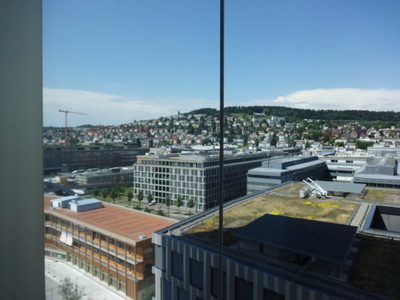 On the approach to Zurich, our guide recommended that we convert very little money to Swiss francs, which after all, aren't good anywhere else, and converting them back would just cost extra. She said it's not usual to tip in Switzerland, and that almost anyone would take a credit card. We found that to be the case—we didn't convert any money at all.
On the approach to Zurich, our guide recommended that we convert very little money to Swiss francs, which after all, aren't good anywhere else, and converting them back would just cost extra. She said it's not usual to tip in Switzerland, and that almost anyone would take a credit card. We found that to be the case—we didn't convert any money at all.
As promised, we rolled up to our hotel, the Zurich Renaissance Tower—a tall, square, concrete-and-glass tower—just about 3 p.m. Its door was guarded by this rather gaudily decorated, 3-foot high, fiberglas bulldog with an "R" for "Renaissance" on his side. Not a Pompon, but a nice bulldog nontheless. Also as promised, our rooms were ready, so we just grabbed our luggage as it was taken off the bus, stopped by reception to pick up our keys, and headed upstairs. At the right is the view from my window down onto the green roof of Technopark, next door. Not the lush pond with cattails, reeds, frogs, and birds that used to top the old Shaw's building in Tallahassee, but a nice enough carpet of short grasses and "rock garden" plants, mostly Sedum, I think, lots of it in bright yellow bloom. A set of miniature railroad tracks run all the way around the edge of the roof, and the object sticking up in the middle, looking like a wheelbarrow, runs around on them as a mobile suspension point from which window-washing staging is hung. Good idea.
We were in district 4 of Zurich, mostly modern and high-tech, not much residential or retail. Technopark is a huge start-up incubator.
The only meal Viking would provide during our stay in Zurich was breakfast, so after settling in, I got on the internet to explore nearby restaurant options. I came up with a list of three, one of which was an American-style bbq joint (why did we fly to Europe, again?), so we went to the nearer of the other two, an Italian place called Toscana, and it was a real winner.

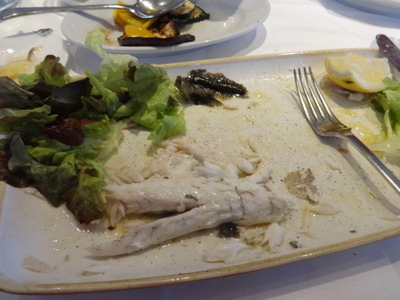 We were there fairly early, before most other customers, but one tiny old lady was sitting on the terrace with a plate of watermelon chunks, which she was slowly but happily munching away at. At one point, she waved over a waiter to cut the larger ones into smaller pieces for her. (Later, a woman I took to be the owner's wife helped her up and escorted her away around the corner of the street.)
We were there fairly early, before most other customers, but one tiny old lady was sitting on the terrace with a plate of watermelon chunks, which she was slowly but happily munching away at. At one point, she waved over a waiter to cut the larger ones into smaller pieces for her. (Later, a woman I took to be the owner's wife helped her up and escorted her away around the corner of the street.)
We started with beef ravioli with sundried tomatoes and cream, and they were out of this world. They were stuffed with finely chopped braised short ribs and were scrumptious.
I then ordered grilled filet of branzino (bar, Dicentrarchus labrax). It was delicious (as you can see, I ate a good bit of it before taking the photo), but it clearly had been boned after cooking. If I'd known they were going to grill it on the bone, I'd have asked them to bring it to me whole.
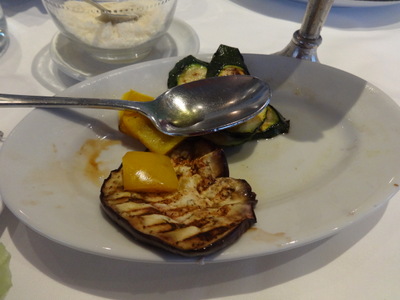
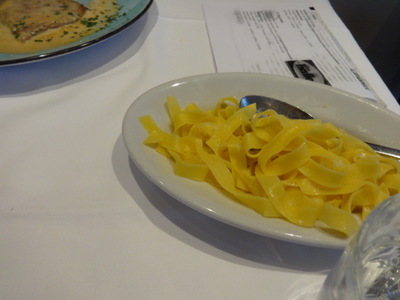 With the fish, I got this plate of grilled vegetables (eggplant, peppers, and zucchini), and a plate of plain pasta. The revelation of the meal was the pasta. It was freshly house made and so flavorful and delicious, that you could just eat it plain, no sauce, no cheese, no nothing. Just utterly delicious by itself!
With the fish, I got this plate of grilled vegetables (eggplant, peppers, and zucchini), and a plate of plain pasta. The revelation of the meal was the pasta. It was freshly house made and so flavorful and delicious, that you could just eat it plain, no sauce, no cheese, no nothing. Just utterly delicious by itself!
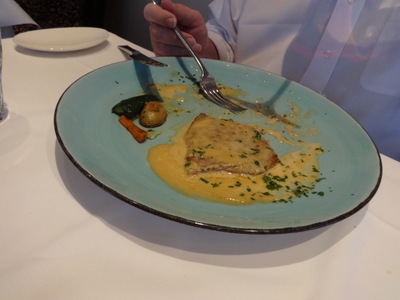
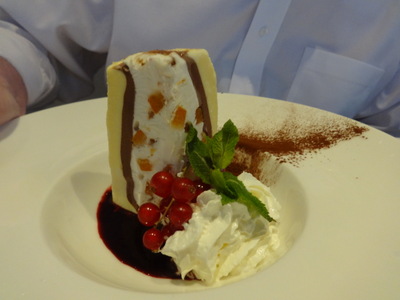 David had a veal cutlet in a creamy lemon sauce, with a different assortment of grilled veggies on the side.
David had a veal cutlet in a creamy lemon sauce, with a different assortment of grilled veggies on the side.
For dessert, he ordered "cassata." Now, the Sicilian cassata I make is pound cake layered with a sweetened ricotta mixture and frosted with fudge, but what David got was this wedge (viewed end-on) of an elaborate ice cream bomb with glacé fruit in the center. It looked amazing!
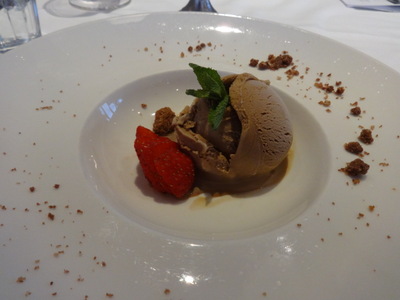
 My ice cream dessert was somewhat simpler in appearance, but the flavor was an elaborate composite of coffee, chocolate, and caramel.
My ice cream dessert was somewhat simpler in appearance, but the flavor was an elaborate composite of coffee, chocolate, and caramel.
At the right here is the other ornament of our hotel's front door. It's a rock, more or less rectangular, more or less square in cross section, maybe 10 feet high, and otherwise featureless, so far as I could tell.
Previous entry
List of Entries
Next entry

 While we ate our breakfast, a barge cruised by that had clearly been retrofitted (left-hand photo); it was called Lorin and was registered in Basel. It rode high in the water and had windows all along its sides. At the time, I took it for a hotel barge, like the Linquenda, on which we toured Champagne many years ago, but as I study the photo, I'm not so sure. The Linquenda had a cabin above the deck with dining tables and panoramic windows, but this boat doesn't, and all signs of living activities (café tables and chairs, flower pots) are confined to the after deck,. Someone clearly lives aboard, but maybe the windows are actually some sort of special cargo fitting . . .
While we ate our breakfast, a barge cruised by that had clearly been retrofitted (left-hand photo); it was called Lorin and was registered in Basel. It rode high in the water and had windows all along its sides. At the time, I took it for a hotel barge, like the Linquenda, on which we toured Champagne many years ago, but as I study the photo, I'm not so sure. The Linquenda had a cabin above the deck with dining tables and panoramic windows, but this boat doesn't, and all signs of living activities (café tables and chairs, flower pots) are confined to the after deck,. Someone clearly lives aboard, but maybe the windows are actually some sort of special cargo fitting . . .
 I think the little blue boat at the left is a tug
I think the little blue boat at the left is a tug
 Back in Grosse Basel (Big Basel), we drove by the Gate of Spalen (the Spalentorm, left), which is, of course, left over from the old city wall. It's now a major landmark and so central that we drove by it several times in the course of our bus tour.
Back in Grosse Basel (Big Basel), we drove by the Gate of Spalen (the Spalentorm, left), which is, of course, left over from the old city wall. It's now a major landmark and so central that we drove by it several times in the course of our bus tour. 
 Another building we drove by several times is the Children's hospital. The architect wanted to make it nonintimidating to children, so on all four sides, he installed these prismatic panels that change apparent color as you walk or drive by. As you approach, they're green, but they change to yellow and then to deep orange, gold, and red as you pass, then fade to green again behind you. Amazing!
Another building we drove by several times is the Children's hospital. The architect wanted to make it nonintimidating to children, so on all four sides, he installed these prismatic panels that change apparent color as you walk or drive by. As you approach, they're green, but they change to yellow and then to deep orange, gold, and red as you pass, then fade to green again behind you. Amazing!
 At the left, I think this is the Lutheran church, but it could be St. Peter's (also protestant).
At the left, I think this is the Lutheran church, but it could be St. Peter's (also protestant).
 At the left here is a view of Basel Cathedral from the bus, on its way to drop us off for our city walking tour. It has the same sort of colored tile roof as the Hospices de Beaune and so many other churches in Burgundy (see my 2009 travel diary).
At the left here is a view of Basel Cathedral from the bus, on its way to drop us off for our city walking tour. It has the same sort of colored tile roof as the Hospices de Beaune and so many other churches in Burgundy (see my 2009 travel diary).
 At the left here is closer view of a couple of the figures in the fountain. We've also visited the Stravinsky Fountain in Paris, on which Tinguely collaborated with his second wife, Niki de Saint Phalle, who was also an artist and has several works displayed in Basel, including in the conference venue in the train station. It was only when I looked her up to make sure I had her name spelled right that I realized she spent a lot of time in San Diego and was in fact the creator of the Sun God on the UCSD campus, affectionately know there as Big Bird! The Stravinsky's kinship with both the the Basel fountain and Big Bird is obvious, once you know.
At the left here is closer view of a couple of the figures in the fountain. We've also visited the Stravinsky Fountain in Paris, on which Tinguely collaborated with his second wife, Niki de Saint Phalle, who was also an artist and has several works displayed in Basel, including in the conference venue in the train station. It was only when I looked her up to make sure I had her name spelled right that I realized she spent a lot of time in San Diego and was in fact the creator of the Sun God on the UCSD campus, affectionately know there as Big Bird! The Stravinsky's kinship with both the the Basel fountain and Big Bird is obvious, once you know.
 Basel was Catholic until the reformation; since then it's been mainly Presbyterian. At the right here is a close-up of of St. Martin sharing his cloak with the beggar, but for some reason the beggar was removed at the reformation (why?), so now he's just cutting his cloak in half for no obvious reason.
Basel was Catholic until the reformation; since then it's been mainly Presbyterian. At the right here is a close-up of of St. Martin sharing his cloak with the beggar, but for some reason the beggar was removed at the reformation (why?), so now he's just cutting his cloak in half for no obvious reason.
 At the left here is a new of the nave, and at the right a view in the other direction toward the organ. The organ is quite recent, only 13 years old. It has (I think she said) 1100 pipes. The stained glass is 19th century; the church has no altars.
At the left here is a new of the nave, and at the right a view in the other direction toward the organ. The organ is quite recent, only 13 years old. It has (I think she said) 1100 pipes. The stained glass is 19th century; the church has no altars.
 The cloister, as usual, was beautiful—that's David up ahead of me in the blue shirt and Tilly hat—but for some reason the garden in the center (right-hand photo) has been allowed to go to weeds and ruin.
The cloister, as usual, was beautiful—that's David up ahead of me in the blue shirt and Tilly hat—but for some reason the garden in the center (right-hand photo) has been allowed to go to weeds and ruin.
 Like many of the other major churches we've visited on this trip, this one also has a bronze scale model outside, labeled in Braille.
Like many of the other major churches we've visited on this trip, this one also has a bronze scale model outside, labeled in Braille.
 Because the water is now clean and safe, it has become very popular for swimming. All over the city, you see people walking around carrying lightweight, brightly colored, bags made of ripstop nylon and shaped like fish. They're called "wickelfisch," they come in large and small, and you can buy them just about anywhere. They're waterproof, so you can put your clothes, briefcase, phone, and everything else inside, go straight to the river from work, hop in and float/swim downstream the length of the city, climb out, and take the tram or bus home. If you blow up the empty space inside with air, you can use it as a float, and they come equipped with straps so that you can wear them like a backpack or fasten them around your waist. They were invented here in Basel, although (the guide said with disdain) people in Zurich have copied the idea.
Because the water is now clean and safe, it has become very popular for swimming. All over the city, you see people walking around carrying lightweight, brightly colored, bags made of ripstop nylon and shaped like fish. They're called "wickelfisch," they come in large and small, and you can buy them just about anywhere. They're waterproof, so you can put your clothes, briefcase, phone, and everything else inside, go straight to the river from work, hop in and float/swim downstream the length of the city, climb out, and take the tram or bus home. If you blow up the empty space inside with air, you can use it as a float, and they come equipped with straps so that you can wear them like a backpack or fasten them around your waist. They were invented here in Basel, although (the guide said with disdain) people in Zurich have copied the idea.
 Almost straight down below us was a small wooden ferry boat that would hold maybe 20 or 30 people. It was tethered by a cable decorated with colored flags to a larger cable that stretched across the river from side to side.
Almost straight down below us was a small wooden ferry boat that would hold maybe 20 or 30 people. It was tethered by a cable decorated with colored flags to a larger cable that stretched across the river from side to side. 
 This extremely red building is Basel's town hall. It is brightly painted inside and out with a wide variety of motifs and, like the cathedral, has a colored tile roof. The little steeple on top has one bell in it, presumably to ring the hours, announce town meetings, or some such. The row of shields along the lower edge of the roof are painted with symbols (though a couple are blank); some look like the signs of the zodiac or maybe the attributes of apostles. One is a guy with a shoulder bag, a halo, and a shepherd's crook (St. James?).
This extremely red building is Basel's town hall. It is brightly painted inside and out with a wide variety of motifs and, like the cathedral, has a colored tile roof. The little steeple on top has one bell in it, presumably to ring the hours, announce town meetings, or some such. The row of shields along the lower edge of the roof are painted with symbols (though a couple are blank); some look like the signs of the zodiac or maybe the attributes of apostles. One is a guy with a shoulder bag, a halo, and a shepherd's crook (St. James?).

 To might right as I took the last photo, at the bottom of the staircase, is this statue of Lucius Munatius Plancus, Roman founder of Basel. At the time the statue went up, the Romans were thought to have founded the city, but 40 years ago, somebody proved that the Helvetians (a Celtic tribe) had built a town here before the Romans showed up. Interestingly, Lucius Munatius Plancus is also cited as the founder of Lyon, in France, but I don't whether someone else was there ahead of him too.
To might right as I took the last photo, at the bottom of the staircase, is this statue of Lucius Munatius Plancus, Roman founder of Basel. At the time the statue went up, the Romans were thought to have founded the city, but 40 years ago, somebody proved that the Helvetians (a Celtic tribe) had built a town here before the Romans showed up. Interestingly, Lucius Munatius Plancus is also cited as the founder of Lyon, in France, but I don't whether someone else was there ahead of him too.
 In one of those narrow streets we passed the Morrison Hotel (named for Jim Morrison), which is apparently quite famous among a crtain set of people. The owner commissioned this mural on the flat wall across the street from his front door, and inside, you can visit his extensive collection of rock memorabilia.
In one of those narrow streets we passed the Morrison Hotel (named for Jim Morrison), which is apparently quite famous among a crtain set of people. The owner commissioned this mural on the flat wall across the street from his front door, and inside, you can visit his extensive collection of rock memorabilia.
 With his lunch, David had a glass of this local beer.
With his lunch, David had a glass of this local beer. One thing I noticed right away was the occurrence in each tram of cars with these markings on the doors. Some had one marking, some the other, and some had both (or neither). We didn't see either of them used, but apparently, the threshold of the door does something special when it opens to allow entry to wheeled conveyances, and presumably something different for wheelchairs and for strollers and baby carriages.
One thing I noticed right away was the occurrence in each tram of cars with these markings on the doors. Some had one marking, some the other, and some had both (or neither). We didn't see either of them used, but apparently, the threshold of the door does something special when it opens to allow entry to wheeled conveyances, and presumably something different for wheelchairs and for strollers and baby carriages.
 On the approach to Zurich, our guide recommended that we convert very little money to Swiss francs, which after all, aren't good anywhere else, and converting them back would just cost extra. She said it's not usual to tip in Switzerland, and that almost anyone would take a credit card. We found that to be the case—we didn't convert any money at all.
On the approach to Zurich, our guide recommended that we convert very little money to Swiss francs, which after all, aren't good anywhere else, and converting them back would just cost extra. She said it's not usual to tip in Switzerland, and that almost anyone would take a credit card. We found that to be the case—we didn't convert any money at all.
 We were there fairly early, before most other customers, but one tiny old lady was sitting on the terrace with a plate of watermelon chunks, which she was slowly but happily munching away at. At one point, she waved over a waiter to cut the larger ones into smaller pieces for her. (Later, a woman I took to be the owner's wife helped her up and escorted her away around the corner of the street.)
We were there fairly early, before most other customers, but one tiny old lady was sitting on the terrace with a plate of watermelon chunks, which she was slowly but happily munching away at. At one point, she waved over a waiter to cut the larger ones into smaller pieces for her. (Later, a woman I took to be the owner's wife helped her up and escorted her away around the corner of the street.)
 With the fish, I got this plate of grilled vegetables (eggplant, peppers, and zucchini), and a plate of plain pasta. The revelation of the meal was the pasta. It was freshly house made and so flavorful and delicious, that you could just eat it plain, no sauce, no cheese, no nothing. Just utterly delicious by itself!
With the fish, I got this plate of grilled vegetables (eggplant, peppers, and zucchini), and a plate of plain pasta. The revelation of the meal was the pasta. It was freshly house made and so flavorful and delicious, that you could just eat it plain, no sauce, no cheese, no nothing. Just utterly delicious by itself!
 David had a veal cutlet in a creamy lemon sauce, with a different assortment of grilled veggies on the side.
David had a veal cutlet in a creamy lemon sauce, with a different assortment of grilled veggies on the side.
 My ice cream dessert was somewhat simpler in appearance, but the flavor was an elaborate composite of coffee, chocolate, and caramel.
My ice cream dessert was somewhat simpler in appearance, but the flavor was an elaborate composite of coffee, chocolate, and caramel.